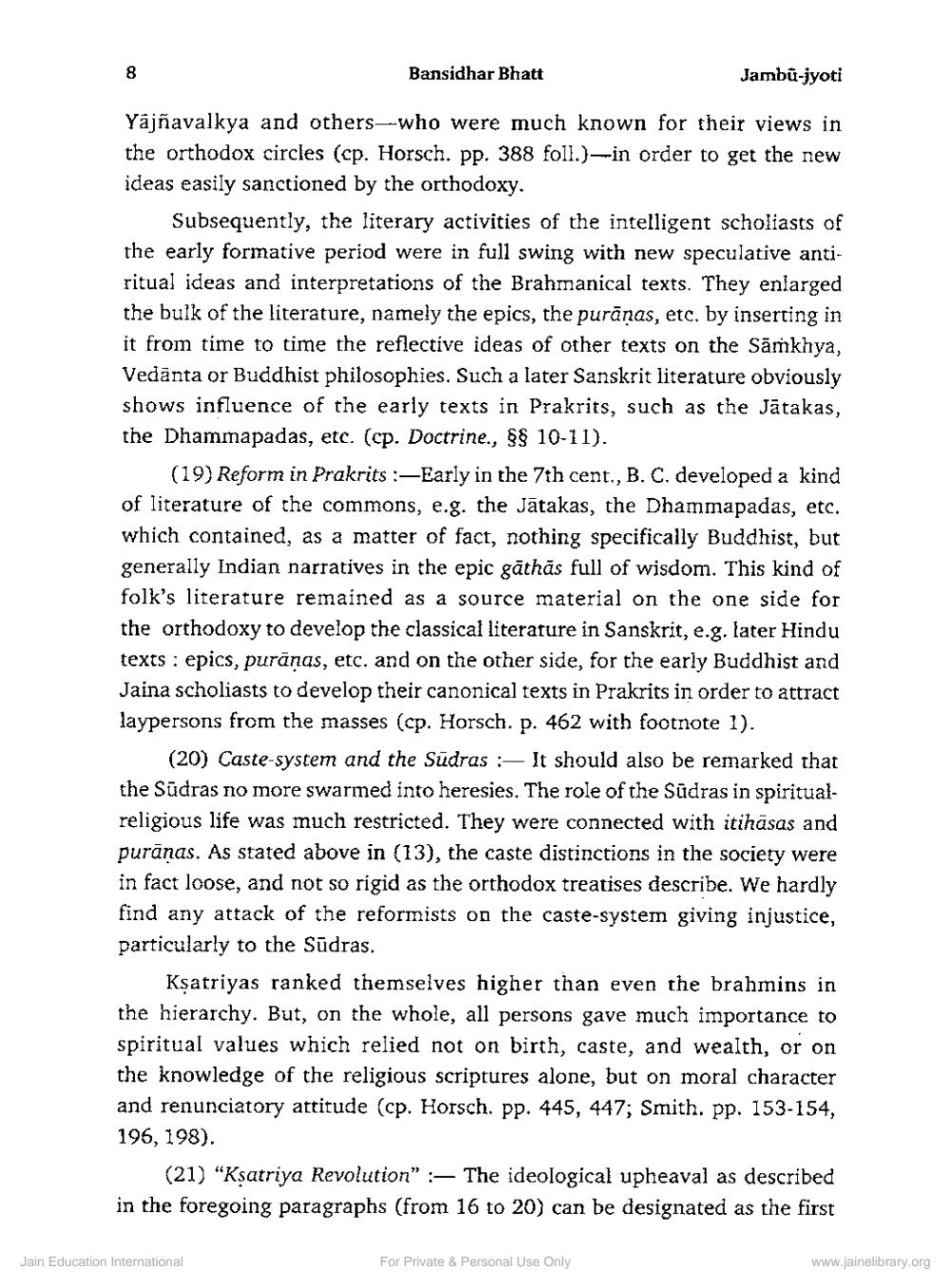Book Title: Jainism vis a vis Brahmanism Author(s): Bansidhar Bhatt Publisher: Z_Nirgranth_Aetihasik_Lekh_Samucchay_Part_1_002105.pdf and Nirgranth_Aetihasik_Lekh_Samucchay_Part_2 View full book textPage 8
________________ Bansidhar Bhatt Jambû-jyoti Yajñavalkya and others who were much known for their views in the orthodox circles (cp. Horsch. pp. 388 foll.)-in order to get the new ideas easily sanctioned by the orthodoxy. Subsequently, the literary activities of the intelligent scholiasts of the early formative period were in full swing with new speculative antiritual ideas and interpretations of the Brahmanical texts. They enlarged the bulk of the literature, namely the epics, the puranas, etc. by inserting in it from time to time the reflective ideas of other texts on the Sāmkhya, Vedānta or Buddhist philosophies. Such a later Sanskrit literature obviously shows influence of the early texts in Prakrits, such as the Jātakas, the Dhammapadas, etc. (cp. Doctrine., $$ 10-11). (19) Reform in Prakrits :-Early in the 7th cent., B. C. developed a kind of literature of the commons, e.g. the Jātakas, the Dhammapadas, etc. which contained, as a matter of fact, nothing specifically Buddhist, but generally Indian narratives in the epic gāthās full of wisdom. This kind of folk's literature remained as a source material on the one side for the orthodoxy to develop the classical literature in Sanskrit, e.g. later Hindu texts : epics, purānas, etc. and on the other side, for the early Buddhist and Jaina scholiasts to develop their canonical texts in Prakrits in order to attract laypersons from the masses (cp. Horsch. p. 462 with footnote 1). (20) Caste-system and the Sudras :- It should also be remarked that the Sūdras no more swarmed into heresies. The role of the Sūdras in spiritualreligious life was much restricted. They were connected with itihāsas and purānas. As stated above in (13), the caste distinctions in the society were in fact loose, and not so rigid as the orthodox treatises describe. We hardly find any attack of the reformists on the caste-system giving injustice, particularly to the Sūdras. Kșatriyas ranked themselves higher than even the brahmins in the hierarchy. But, on the whole, all persons gave much importance to spiritual values which relied not on birth, caste, and wealth, or on the knowledge of the religious scriptures alone, but on moral character and renunciatory attitude (cp. Horsch. pp. 445, 447; Smith. pp. 153-154, 196, 198). (21) “Ksatriya Revolution" :- The ideological upheaval as described in the foregoing paragraphs (from 16 to 20) can be designated as the first Jain Education International For Private & Personal Use Only www.jainelibrary.orgPage Navigation
1 ... 6 7 8 9 10 11 12 13 14 15 16 17 18 19 20 21 22 23 24 25 26 27 28 29 30 31 32 33 34 35 36 37 38 39 40 41 42 43 44 45 46 47
